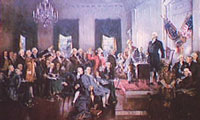 |
||
  |
||
|
|
The Constitutional Convention: Four Founding Fathers You May Never Have Met"Alexander Hamilton of New York—a brilliant, ambitious, former aide-de-camp and secretary to Washington during the Revolution, had…become a powerful political figure….There were others who played major roles—Oliver Ellsworth of Connecticut; Edmund Randolph of Virginia; William Paterson of New Jersey…" IntroductionIn the course of over two centuries since the nation's founding, the Constitution of the United States has become an iconic document for many Americans, who may with difficulty imagine real people piecing it together detail by painstaking detail through meetings, discussions, committee work, and compromise. Yet we have good records of those proceedings. By means of such records, among them James Madison's extensive notes, we can witness the unfolding drama of the Constitutional Convention and the contributions of those men we have come to know as the Founding Fathers: Madison, Benjamin Franklin, Thomas Jefferson, and George Washington, among the best known. There were others, however, less well known now but who also played major roles in founding the new nation. Four such "others" are the subject of this lesson. Here, you'll introduce your students to four key, but relatively unknown, contributors to the U.S. Constitution-Oliver Ellsworth, Alexander Hamilton, William Paterson, and Edmund Randolph. Learn through their words and the words of others how the Founding Fathers created "a model of cooperative statesmanship and the art of compromise" (From The Charters of Freedom on the EDSITEment resource Digital Classroom). Note: Use this lesson as a prequel to, or in conjunction with, the complementary lesson, Constitutional Convention: What the Founding Fathers Said. By completing the activities in both lesson, students will become familiar with the Constitutional Convention and the men and ideas that shaped the U.S. Constitution Guiding Question:What is the connection between regional politics and the positions of Ellsworth, Hamilton, Paterson, and Randolph during the drafting of the U.S. Constitution? What other factors motivated these four Founding Fathers as they developed their positions in the debate? Learning ObjectivesAfter completing this lesson plan, students will be able to:
Preparing to Teach this Lesson
Suggested Activities1 Introducing the Constitutional Convention 2 Group Assignment: Getting to Know a Founding Father 3 Oral Presentations and Class Discussion 1 Introducing the Constitutional Convention As necessary, begin by reviewing with students the Virginia, New Jersey, and Hamilton Plans, as well as the Great Compromise (Connecticut Plan). If desired, use the summaries found in the Preparing to Teach This Lesson section, above. Adapt the "Chart of Various Plans (Blank)" on page 1 of the PDF file (see Preparing to Teach This Lesson, above, for download instructions) as an organizer to help students see the differences and similarities between the various plans. The "Chart of Various Plans"—the same chart, complete with information-is available on page 2 of the PDF file (see Preparing to Teach This Lesson, above, for download instructions). Here are some additional sources of information to use in your review:
2 Group Assignment: Getting to Know a Founding Father Divide the class into four groups and assign one of the selected Founding Fathers-Ellsworth, Hamilton, Paterson, and Randolph-to each group. Download, copy and distribute to the respective groups some or all of the following brief biographies, available on EDSITEment resources. (NOTE TO THE TEACHER: You can encourage students to use other resources in the classroom and library as well. If a typical group consists of five students, one or two students could read one biography while other students look for additional resources using the computer or library. When the group reconvenes, students can combine what they have learned into one account.)
As students read biographies of their assigned Founding Father, they should attempt to answer the following questions:
3 Oral Presentations and Class Discussion Based on their reading of the biographies and/or other sources available in the classroom, each group should distribute a brief (one page typed) composite biography to the entire class and present an oral argument that their assignee deserves to be better known. Students can consider achievements before, during, and after the Convention. After all the groups have presented their arguments, allow time for students to review the biographies offered by the different groups. Discuss the plans with reference to the biographies. How did each plan differ? What regional factors led to the inclusion of specific elements in each plan that deal with issues such as how states would be represented in the national legislature or how the population would be counted for the purpose of taxation and representation? What parts of any plan connect to the biography of its author? What parts of which plans eventually became part of the Constitution? Challenge students to match quotes from the debates with either Ellsworth, Hamilton, Paterson, or Randolph. Using the "Four Fathers' Quotes" handout on pages 3-6 of the Three Handouts pdf file (see Preparing to Teach This Lesson, above, for download instructions), adapt this activity to a game show format or a more simple pencil-and-paper activity. If time permits, students could even create their own game. Extending the Lesson
Selected EDSITEment Websites
Standards Alignment View your state’s standards |
||||||||||||||||||||||||||||||||||||||||||||||||||||||||||||||
  |
||
| EDSITEment contains a variety of links to other websites and references to resources available through government, nonprofit, and commercial entities. These links and references are provided solely for informational purposes and the convenience of the user. Their inclusion does not constitute an endorsement. For more information, please click the Disclaimer icon. | ||
| Disclaimer | Conditions of Use | Privacy Policy Search
| Site
Map | Contact
Us | ||
